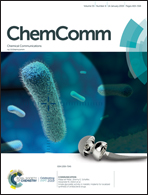Metal-catalyzed cross-coupling chemistry with polyhedral boranes
Abstract
Over the past several decades, metal-catalyzed cross-coupling has emerged as a very powerful strategy to functionalize carbon-based molecules. More recently, some of the cross-coupling methodologies have been adapted to inorganic compounds including boron-rich clusters. The development of this chemistry relies on the ability to synthesize halogenated boron-rich clusters which can serve as electrophilic cross-coupling partners with nucleophilic substrates in the presence of a metal catalyst. While the cross-coupling chemistry with boron-clusters is conceptually reminiscent of that of its hydrocarbon counterparts, several key aspects including the spheroidal bulk of clusters and the distinct nature of boron–halogen/boron–heteroatom bonds make this chemistry unique. The utility of metal-catalyzed cross-coupling can be extended to several classes of polyhedral boranes including neutral and anionic carboranes, metallaboranes, and carbon-free boranes. Importantly, cross-coupling enables a suite of boron–heteroatom (C, N, O, P, S) couplings to prepare boron cluster-based systems that can be used for ligand design, medicinal chemistry, and materials applications.



 Please wait while we load your content...
Please wait while we load your content...